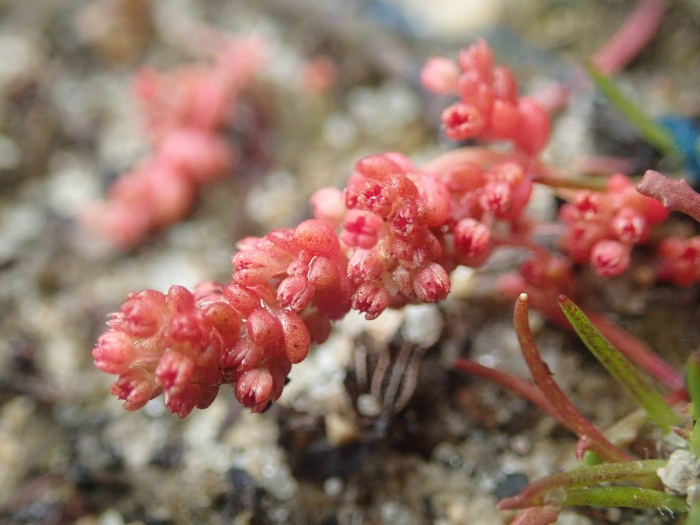Sand Pygmyweed
(Crassula connata)
Sand Pygmyweed (Crassula connata)
/
/

© Cricket Raspet
CC BY 4.0
Image By:
© Cricket Raspet
Recorded By:
Copyright:
CC BY 4.0
Copyright Notice:
Photo by: © Cricket Raspet | License Type: CC BY 4.0 | License URL: http://creativecommons.org/licenses/by/4.0/ | Uploader: chilipossum | Publisher: iNaturalist |











Estimated Native Range
Summary
Crassula connata, commonly known as sand pygmyweed or pygmy stonecrop, is a succulent plant native to a variety of habitats including coastal bluffs, rocky outcrops, and vernal pools in western North America, as well as extending into parts of Central and South America. It is a low-growing plant, typically only a few centimeters tall, with sprawling stems that can form dense mats. The fleshy leaves are small and can change color from green to pink and red as they mature, adding seasonal interest. Sand pygmyweed produces inconspicuous white to pale pink flowers from late spring to early summer, which are not particularly showy but do attract pollinators.
In cultivation, Crassula connata is valued for its drought tolerance and ability to grow in poor soils, making it an excellent choice for rock gardens, xeriscaping, and as a ground cover in arid landscapes. It requires minimal maintenance and is easily propagated from cuttings. This plant prefers full sun to partial shade and thrives in dry, well-drained soils. It is not known for having aggressive roots or being prone to diseases, making it a hassle-free addition to gardens. However, it can be sensitive to overwatering, which can lead to root rot. Gardeners should be cautious of its potential to spread in favorable conditions, as it can become invasive outside its native range.CC BY-SA 4.0
In cultivation, Crassula connata is valued for its drought tolerance and ability to grow in poor soils, making it an excellent choice for rock gardens, xeriscaping, and as a ground cover in arid landscapes. It requires minimal maintenance and is easily propagated from cuttings. This plant prefers full sun to partial shade and thrives in dry, well-drained soils. It is not known for having aggressive roots or being prone to diseases, making it a hassle-free addition to gardens. However, it can be sensitive to overwatering, which can lead to root rot. Gardeners should be cautious of its potential to spread in favorable conditions, as it can become invasive outside its native range.CC BY-SA 4.0
Plant Description
- Plant Type: Herb
- Height: 0.1-0.5 feet
- Width: 0.5-1 feet
- Growth Rate: Moderate
- Flower Color: Green, Pink, White
- Flowering Season: Spring, Winter
- Leaf Retention:
Growth Requirements
- Sun: Full Sun, Part Shade
- Water: Low
- Drainage: Medium, Fast
Common Uses
Drought Tolerant, Low Maintenance, Rock Garden
Natural Habitat
Native to coastal bluffs, rocky outcrops, and vernal pools in western North America, and extending into Central and South America
Other Names
Common Names: Erect Pygmyweed, Pygmyweed Crassula
Scientific Names: , Crassula connata, Crassula erecta, Crassula minima, Crassula tillaea, Tillaea connata, Tillaea diffusa, Tillaea diffusa, Tillaea erecta, Tillaea minima
GBIF Accepted Name: